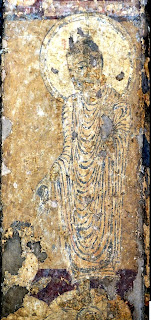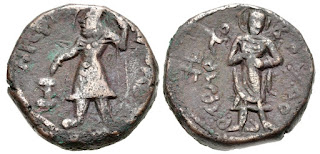Buddhism originated around the 6th century BC. Greeks trade with India started centuries before Alexander's invasion in India that was in 326 BC. Greco-Buddhism is the cultural syncretism between Hellenistic culture (started during the time between the death of Alexander the Great in 323 BC to the death of Cleopatra VII, or 30 BC) and Buddhism, which developed between the 4th century BC and the 5th century AD and flourished for a period of more than 800 years. The philosophical, peaceful and liberating teachings of Buddha had a great impact on Hellenism. Following Alexander's death, after he left India, the successors founded their own kingdoms in Asia minor and Central Asia.
Greco-Buddhism followed the Mauryan Empire (322-183 BC), Seleucid Empire, the Indo-Greek Kingdoms and the Kushan Empire (1st to 3rd century AD). In fact, Chandragupta Maurya's wife was Seleucus I Nicator's (Seleucid Empire) daughter Helena. Buddhism spread to Gandhara, Central Asia and through the silk route to China, Korea, Japan, East and Southeast Asia.
Pyrrho of Elis travelled with Alexander, during the Greek invasion from 334-324 BC, and met with Buddhist masters. They impacted and shaped the philosophy of Pyrrho, who preserved these. Pyrrho's Buddhist thought had a major impact on Western philosophy and on Pyrrhonism.
While the term ''Buddha'' is used in the Agamas (scriptures of ancient Buddhist schools, in Prakrit and Sanskrit) and the Pali Canon, (collection of scriptures preserved in Pali language, now translated in various other languages), the oldest surviving written records of the term ''Buddha'' is from the middle of 3rd century BC, in several Edicts of Ashoka (269-232 BC).
Thai Pali Canon, standard edition.
The Indians referred to the Greeks as Yonas (Yavana). Greek was one of the first languages in which part of Buddha's teachings were recorded, including the inscriptions of Emperor Ashoka who followed Buddhism. Greeks were the first Europeans to embrace Buddhism, centuries before the advent of Christianity. There is one school of thought that believes that the first sculptors to depict the Buddha in the form of statues, particularly, the standing statues, were of Greek descent (1st century AD). Before this, Buddha was only represented through his symbols (empty throne, Bodhi Tree, Buddha footprints, the Dharam chakra or the Umbrella). The 14th Dalai Lama says, ''One of the distinguishing features of Gandharan school of art is that it has been clearly influenced by Classical Greek style''.
The arts of the Indian subcontinent were quite affected by Hellenistic art. The iconograph of Vajrapani is clearly that of the Greek divine hero Heracles (Hercules), with varying degrees of hybridization. Menander I (Indo-Greek king, 165-130 BC, whose capital was Sangala, present day Sialkot) was one of the patrons of Buddhism.
Mahadharmaraksita was a Greek Buddhist master who lived during the 2nd century BC, during the reign of Menander I travelled with 30,000 Greek Buddhist monks from Alexandria in the Caucasus (located to the South of Bactria, in the mountains of the Hindu Kush), to Anuradhapura in Sri Lanka (according to Mahavamsa, a historical chronicle of Sri Lanka written in Pali language, 543 BC).
Buddhist gravestones decorated with depictions of the ''Dharma Wheel'' have been found in Alexandria, indicating the presence of Buddhism in Ptolemaic Egypt/. Buddhism spread along the river Nile. The ''Meroitic script resembles Kharosthi signs. In fact, 34 of the 42 signs or 81 percent matched.
Today, there is a sizable Buddhist community in Greece. There are presently many Buddhist Centres in Greece, four Centres formed by the Diamond Way, other Centres are in Athens, Thessaloniki, Sparta and Rhodes.
Buddhist traditions recognize, Emperor Asoka, Menander and Kanishka as the greatest benefactors of Buddhist faith. Kushan monks, such as Lokaksema (178 AD), travelled to the Chinese capital of Loyang, where they became translators of Buddhist scriptures into Chinese.
Although Buddha was depicted on coins by the Buddhist symbols since the 2nd century BC, the iconographic imagery of Buddha was introduced during the Kushan rule on Kanishka I coins, 127-150 AD.
Buddha and Coins
















No comments:
Post a Comment
Any inputs or feedback is welcome!